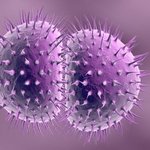Neisseria

Neisseria includes pathogenic for humans species of the Neisseria: the causative agent of gonorrhea (Neisseria gonorrhoeae) and the causative agent of meningitis (Neisseria meningitidis). Traditionally, Neisseria gonorrhoeae is often called gonococcus, Neisseria meningitidis is called meningococcus.
Also, non-pathogenic types of Neisseria bacteria living on mucous membranes (Neisseria sicca, Neisseria mucosa, Neisseria perflava) are found in humans. Under the microscope, Neisseria looks like coffee beans.
Neisseria is found in the stomach of healthy people (when there are no Helicobacter pylori in it in a dominant rate).
A number of Neisseria species, in particular, N. bacilliformis, N. cinerea, N. elongata, N. flavescens, N. lactamica, N. mucosa, N. perflava, N. polysaccharea, N. sicca, N. subflava, are non-pathogenic. However, these species may also be associated with certain diseases.
Neisseria lactamica is present in the nasopharynx of many healthy children. Antigens of human-friendly Neisseria lactamica and Neisseria meningitidis are the same, therefore, the presence of Neisseria lactamica presumably prevents the development of meningitis.

